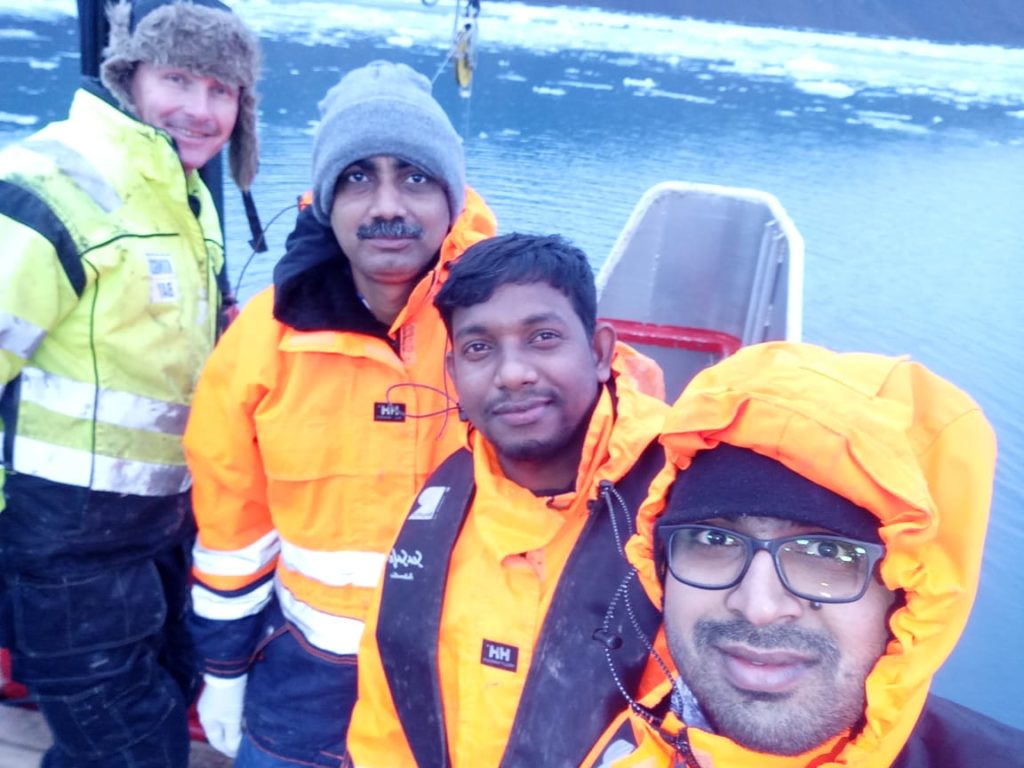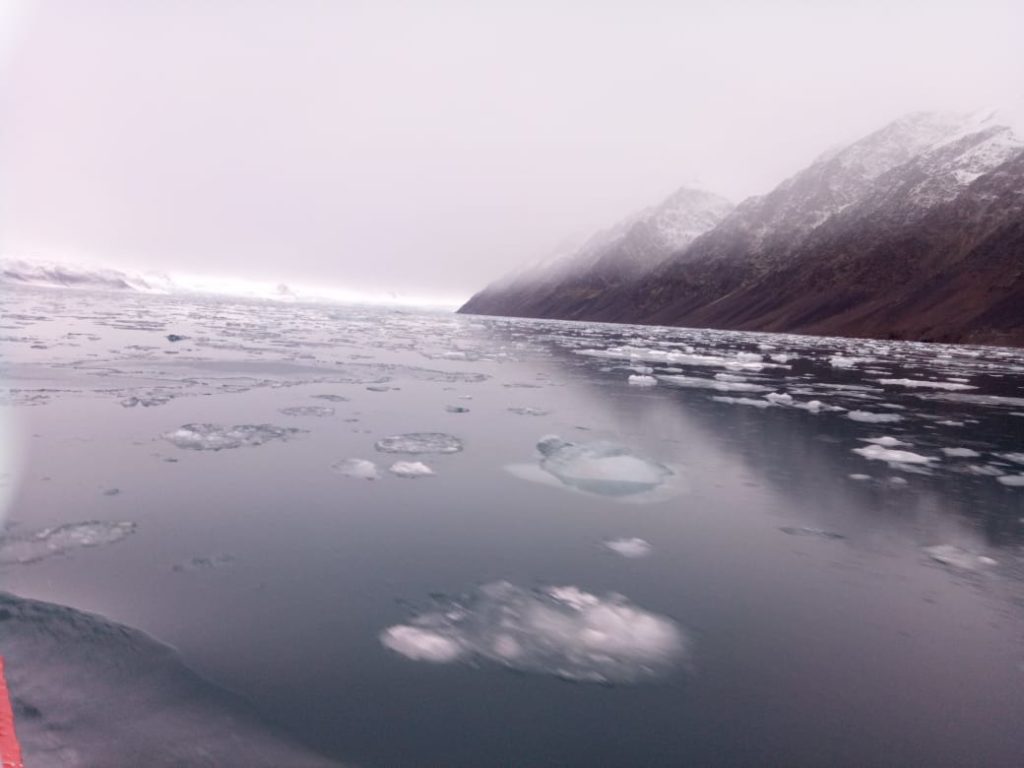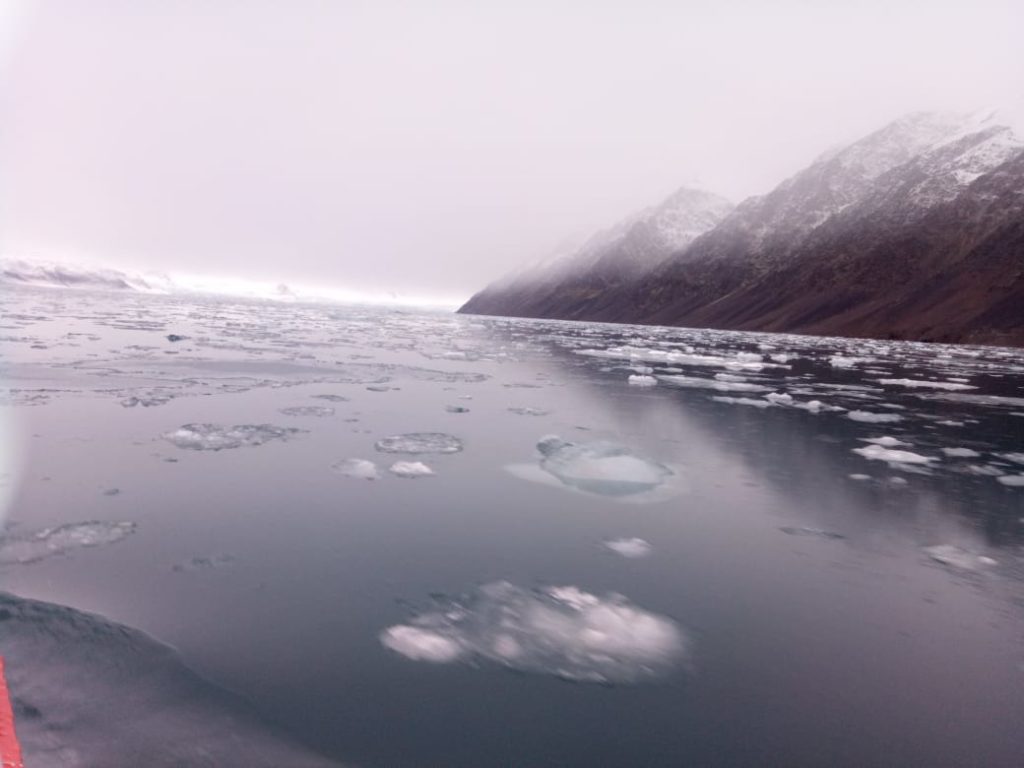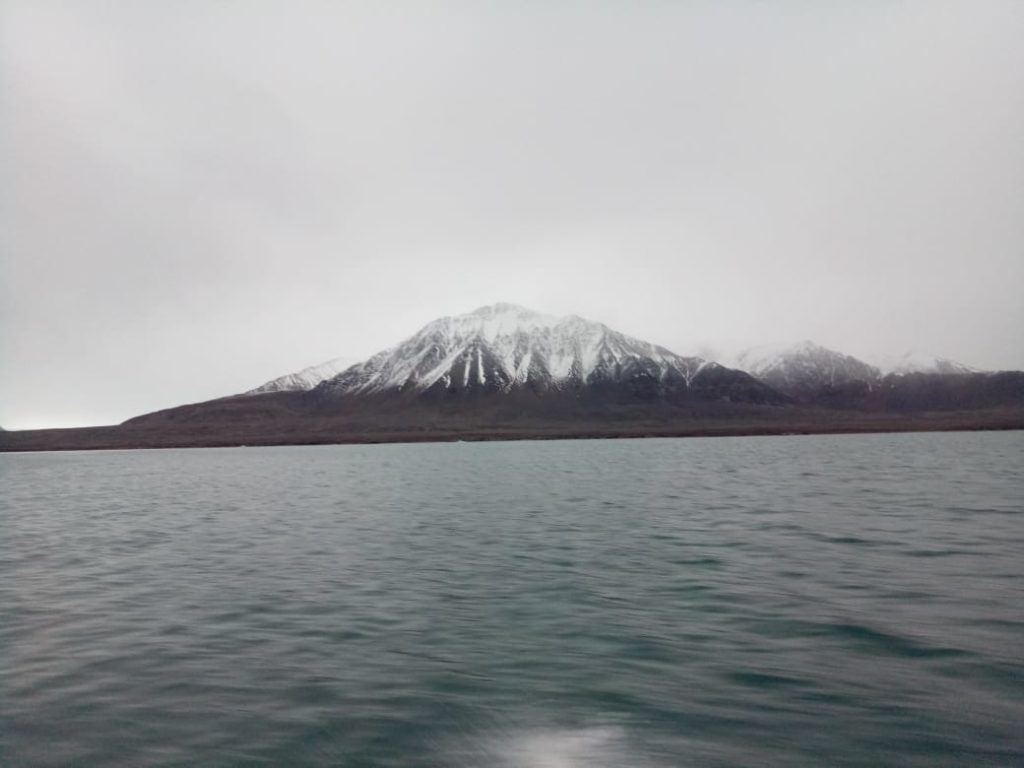RESEArCH
RESEARCH INTERESTS
Scanning of Emerging Contaminants in Aquatic Matrices of Arctic Region
Arctic is one of the largest and most pristine regions of the world. The main features of this area are cold climate, ice, darkness, and polar lows.Arctic region is susceptible to environmental pollution due to the environmental diversity, absence of nutrients in the environment and extreme seasonal light variation of the region. Our present work involves the Analysis of sediment/water samples from Arctic region for detection and quantification of micropollutants has also been initiated. The structure of the compounds is identified with the help of the high-resolution mass spectra and MS/MS pattern and the quantification is done by using authentic standards. Protocols are developed for analysis of contaminants. Pre-concentration methods are adopted for bringing the analyte concentrations into the working range of the analytical instruments.




Advanced Oxidation Processes (AOPs) for the degradation of Environmental Pollutants:
AOPs make use of the involvement of a highly oxidizing species like hydroxyl radical and its subsequent oxidative degradation reaction with organic water pollutants (mainly pharmaceuticals and personal care products (PPCPs), pesticides, and substituted phenols). The main AOPs include Ultrasound, Fenton, photolysis (UV & VIS), photocatalysis using TiO2 and radiolysis are generally being used. In addition, Zerovalent iron nanoparticle is yet another system used for similar degradation studies. The kinetics of reaction and the spectroscopic investigation of the short lived intermediate radicals in all these reactions are monitored by Pulse radiolysis technique. The stable intermediate and final products of the degradation are monitored by HPLCs, LC-MS, UPLC-Q-TOF-MS etc. The extent of mineralisation are being studied by TOC and IC.
Scanning of Emerging Pollutants in water and soil:
Air Pollution Monitoring:
Development of nano-membrane based Environmental Sensors for pollutants:
Nanomembrane fabricated from biopolymers that have intrinsic fluorescence can sense air pollutants such as hydrogen peroxide upto pico molar concentrations. Ovalbumin immobilized nanomembranes is too promising in sensing mercury and nitro compounds as well.
Membrane technology for water purification:
Multilayer nano-membranes (biodegradable synthetic membranes) are prepared using polyelectrolytes. Textile and papermill effluents can be treated with such membranes for removing color and COD. This is expected as a superior technology compared conventional methods
Radiation and Photo- induced modifications of DNA and related compounds:
The genetic material, DNA, undergoes constant damages due to both internal and external factors. It undergoes nearly 10,000 damages in human body every day. Radiation induced damages are due to direct deposition of energy and to indirect effect from water derived free radicals. We investigate the damage induced by both low LET and high LET radiation using steady state and pulse radiolysis techniques. Photochemical changes are also being studied. Charge transport in DNA is another important phenomena which is extensively being investigated in our group using Femtosecond spectroscopy.
Computer based theoretical calculations for free radical reactions:
A great deal of information on the probable reaction sites and energy channels in the free radical chemistry of organic compounds can be obtained using Density Functional Theory (DFT) based theoretical calculations. The DFT calculations are carried out with Gaussian 03 suite of programs by employing B3LYP method using the 6-31+G(d,p) basis set.
Experimental tools :
Pulse radiolysis, Laser flash photolysis, Time-resolved spectroscopy, Steady state radiolysis and photolysis, HPLC, HPTLC and other chromatographic techniques, UV-VIS spectrometry, GC-MS, LC-MS, LC-Q-TOF-MS, Highcomputing systems etc
SELECTED PUBLICATIONS (REPRESENTATIVE)
Book chapters:
- Jeeva M. Philip, Usha K. Aravind, C. T. Aravindakumar “Use of Antibiotics in Animals and Its Possible Impacts in the Environment” (pages 77-91), in the “Handbook of Research on Social Marketing and Its Influence on Animal Origin Food Product Consumption” Edited by Diana Bogueva, Dora Marinova, and Talia Raphaely, IGA Global (Idea Group, USA), 2018, ISBN13: 9781522547570
- Usha K. Aravind, Subha Sasi, Mary Lidiya Mathew, C. T. Aravindakumar, Layer by layer (LbL) coated multilayer membranes in dye house effluent treatment (Chapter 22) in “Membrane Technology: Sustainable Solutions in Water, Health, Energy and Environmental Sectors” Edited by S. Sridhar, CRC Press 2018
In Journals (representative)
- Manoj P. Rayaroth, Usha K. Aravind, and C. T. Aravindakumar, Effect of inorganic ions on the ultrasound initiated degradation and product formation of Triphenylmethane dyes, Ultrasonic Sonochemistry, 2018 (in press)
- Subha Sasi, P.R. Manoj, C.T. Aravindakumar and U.K. Aravind, Identification of surfactants and its correlation with physico-chemical parameters at the confluence region of Vembanad Lake in India, Env Sci Pollut. Res., 2018 Jul;25(21):20527-20539. doi: 10.1007/s11356-017-0563-4.
- N. Oturan, C.T. Aravindakumar, H. Olvera-Vargas, S. P. Mathew, M.A. Oturan, Electro-Fenton oxidation of para-aminosalicylic acid: Degradation kinetics and mineralization pathway using Pt/carbon-felt and BDD/carbon-felt cells, Environ. Sc. Pollut. Res., 2018, July, Volume 25(21), 20363–20373
- Jeeva M. Philip, Usha K. Aravind and C.T. Aravindakumar, Emerging Contaminants in Indian Environmental Matrices – A Review, Chemosphere, 2018, Jan;190:307-326. doi: 10.1016
- K.K. Nejumal, D. Dineep, Mahesh Mohan, K.P. Krishnan, U.K. Aravind, C.T. Aravindakumar, Presence of Bisphenol S and Surfactants in the Sediments of Kongsfjorden: A Negative Impact of Human Activities in Arctic?, Environmental Monitoring and Assessment, 2017 Dec 14;190(1):22. doi: 10.1007/s10661-017-6383-7
- Jain Thomas, R. Vishnu, C.T. Aravindakumar, and Usha K. Aravind, Polyelectrolyte Functional Bilayers for the Removal of Model Emerging Contaminants, Industrial Engineering Chemistry Research, 2017, 56 (46), 13874–13884
- S. Thomas, S.V. Abraham, U. K. Aravind and C. T. Aravindakumar, Enhanced degradation of acid red 1 dye using a coupled system of zero valent iron nanoparticles and sonolysis, Environ Sci. Pollut. Res., 2017, 24(31), 24533-24544
- Manoj P. Rayaroth , Usha K. Aravind, and C. T. Aravindakumar, Role of in-situ nitrite ion formation on the sonochemical transformation of para-aminosalicylic acid, Ultrasonic Sonochemistry, 2017, 40, 213-220
- Manoj P. Rayaroth , Chung-Seop Lee, Usha K. Aravind, Charuvila T. Aravindakumar,Yoon-Seok Chang, Oxidative degradation of benzoic acid using Fe0- and sulfidized Fe0-activated persulfate: A comparative study”, Chem. Eng. J., 2017 , 315, 426-436
- Jissy Mathew, G. Akhil, C.T. Aravindakumar, U.K. Aravind Transport properties and morphology of CHI/PSS multilayered microfiltration membranes for the low pressure filtration of amino acids” J. Chem. Tech. Biotech., 2016 DOI: 10.1002/jctb.5067
- Manoj P. Rayaroth, Usha K. Aravind, Charuvila T. Aravindakumar , Degradation of pharmaceutically active compounds by ultrasound based advanced oxidation process: A review, Env. Chem. Lett., 2016, 14, 259-290
- M. P. Rayaroth, U. K. Aravind, C. T. Aravindakumar , Ultrasound based AOP for emerging pollutants: From degradation to mechanism, Environ. Sci. Pollut. Res. 2016 Doi:10.1007/s11356-016-6606-4
- Subha Sasi, M. P. Rayaroth, D. Devadasan, Usha K. Aravind and C. T. Aravindakumar, Influence of inorganic ions and selected emerging contaminants on the degradation of Methylparaben: A sonochemical approach, Journal of Hazardous Materials, 2015, 300, 202-209
- Jisha Chandran, U.K. Aravind, C.T. Aravindakumar, Sonochemical transformation of thymidine: A mass spectrometric study, Ultrasonics Sonochemistry, 2015, 27, 178-186
- S. P. M. Menachery, Olivier Laprévote, Thao P. Nguyen, Usha K. Aravind, G. Pramod and C.T. Aravindakumar, Identification of Position Isomers by Energy-Resolved Mass Spectrometry, Journal of Mass Spectrometry , 2015, 50, 944–950
- Manoj P. Rayaroth, Usha K. Aravind and C.T. Aravindakumar, Sonochemical Degradation of Coomassie Brilliant Blue: Effect of frequency, power density, pH and various additives, Chemosphere, 2015, 119, 848-855
- Akhil Gopalakrishnan, Mary Lidiya Mathew, JishaChandran, Appala Raju Badireddy, Judith Winglee, Mark Wiesner, C. T. Aravindakumar and Usha K. Aravind, Sustainable Polyelectrolyte Multilayer Surfaces: Possible Matrix for Salt/dye Separation, ACS Appl. Mater. Interfaces, 2015, 2015, 7, 3699-3707
- Muna Sh. Yahya, N. Oturan, K. El Kacemi, M. El Karbane, C. T. Aravindakumar, M. A. Oturan, Oxidative Degradation Studies on Antimicrobial Agent Ciprofloxacin by electro-Fenton Process: Kinetics and Oxidation Products, Chemosphere, 2014, 117, 447-54
- M. M. Sunil Paul, U. K. Aravind, G. Pramod, A. Saha, and C. T. Aravindakumar, Hydroxyl Radical Induced Oxidation of Theophylline in Water: A Kinetic and Mechanistic Study, Org. Biomol Chem. 2014, 12 (30), 5611 – 5620
- M. Mathew, S. Sreedhanya, P. Manoj, C. T. Aravindakumar and Usha K. Aravind , Exploring the interaction of bisphenol-S with serum albumins: A better or worse alternative for bisphenol-A?, J. Phys. Chem. B., 2014, 118 (14), 3832–3843
- R. Sreekanth, Sunil Paul M. M, Usha K. Aravind, J.L.Marignier, J.Belloni, C. T. Aravindakumar, Oxidation reactions of hydroxy naphthoquinones: Mechanistic investigation by LC-Q-TOF-MS Analysis, Int. J. Radiat. Biol., 2014, 90(6), 495-502.
- N.B. Shibin, R. Sreekanth, Usha K. Aravind, K.M. Afsal Mohammed, N.V. Chandrashekhar, Jayan Joseph, S. K. Sarkar, D.B. Naik and C.T. Aravindakumar, Radical chemistry of glucosamine naphthalene acetic acid and naphthaleneaceticacid: A pulse radiolysis study, J.Phys.Org. Chem., 2014, 27( 6), 478–483
- Shoniya Thomas, R. Sreekanth, V.A. Sijumon, Usha K Aravind and C.T. Aravindakumar, Oxidative Degradation of Acid Red 1 in Aqueous Medium, Chem. Eng. J., 2014, 244, 473–482
- K.K.Nejumal, P.R. Manoj, Usha K. Aravind, C.T. Aravindakumar, Sonochemical Degradation of a Pharmaceutical Waste, Atenolol, in Aqueous Medium, Environ. Sci. Pollut. Res., 2014, 21, 4297-4308
- Sreekanth, K.P. Prasanthkumar, M.M. Sunil Paul, Usha K. Aravind,, C.T. Aravindakumar, Oxidation Reactions of 1- and 2-naphthols: An Experimental and Theoretical Study, J. Phys. Chem. A., 2013,117, 11261–11270
- V. Divyalakshmi, S. Sreedhanyaa, G. Akhil, C. T. Aravindakumar and Usha K. Aravind, Sub-picomolar sensing of hydrogen peroxide with ovalbumin embedded CHI/PSS multilayer membrane, Analytical Biochemistry, 2013,440, 49-55
- P. Prasanthkumar, C. H. Suresh, C. T. Aravindakumar, Dimer Radical Cation of 4-thiouracil: A pulse radiolysis and theoretical study, J. Phys. Org. Chem., 2013,26, 510-516
- Venu, D.B. Naik, S.K. Sarkar, Usha K. Aravind A.Nijamudheen, C.T.Aravindakumar, Oxidation Reactions of Thymol: A Pulse Radiolysis and Theoretical Study, J. Phys. Chem. A., 2013,117, 291–299
- M. Sunil Paul, Usha K. Aravind, G. Pramod, C.T. Aravindakumar,Oxidative Degradation of Fensulfothion by Hydroxyl Radical in Aqueous Medium, Chemosphere, 2013,91, 295–301
- P. Prasanthkumar, C. H. Suresh and C. T. Aravindakumar, Oxidation Reactions of 2-thiouracil: A Theoretical and Pulse Radiolysis Study,J. Phys. Chem. A. 2012 116 , 10712–10720
- J. Disha, C.T. Aravindakumar, Usha K.Aravind, Phosphate recovery by high flux low pressure multilayer membranes, Langmuir, 2012,28, 12744–12752
- Jissy Mathew, S. Sreedhanya, M.S. Baburaj, C.T. Aravindakumar, U.K. Aravind, Fabrication of switchable protein resistant and adhesive multilayer membranes, Colloids and Surfaces B: Biointerfaces, 2012,94, 118-24
- S. Baburaj, C.T. Aravindakumar, S. Sreedhanya, A.P. Thomas, Usha K. Aravind, Treatment of model textile effluents with PAA/CHI and PAA/PEI composite membranes Desalination, 2012,288, 72–79
- K. Aravind, B. George, M.S. Baburaj, S. Thomas, A.P. Thomas, C.T. Aravindakumar, Treatment of industrial effluents using polyelectrolyte membranes, Desalination,2010, 252, 27–32
- P. Prasanthkumar, Hari Mohan, G. Pramod, C. H. Suresh, and C. T. Aravindakumar, Anomalous reaction of oxide radical ion with 5-azacytosines: An experimental and theoretical study, Chem. Phys. Lett.,2009, 467, 381-386
- Manoj, Chang-Ki Min, C.T. Aravindakumar, T. Joo, Ultrafast charge transfer dynamics in 2-aminopurine modified double helical DNA, Chem. Phys.2008, 352, 333-338
- Jissy Mathew, C.T.Aravindakumar and Usha K Aravind Effect of ionic strength and protein concentration on the transport of proteins through chitosan/polystyrene sulfonate multilayer membrane, J. Membr. Sci.2008, 325, 625-632
- Rani Varghese, Usha K. Aravind and Charuvila T. Aravindakumar, Fenton-Enhanced g- Radiolysis of Cyanuric acid, Hazardous Materials 2007, 142, 555-558
- K. Aravind, J. Mathew and C.T. Aravindakumar, Transport studies of BSA, lysozyme and ovalbumin through chitosan/polystyrene sulfonate multilayer membrane, J. Membr. Sci., 2007, 299, 146-155
- Pramod, K.P. Prasanthkumar, Hari Mohan, V.M.Manoj, P.Manoj, C.H.Suresh, and C.T. Aravindakumar, Reaction of Hydroxyl radicals with Azacytosines: A Pulse Radiolysis and Theoretical Study, J. Phys. Chem. A.2006; 110, 11517 – 11526
- Rani Varghese, Hari Mohan, P. Manoj, V. M. Manoj, Usha K. Aravind, K. Vandana and C. T. Aravindakumar,On the Reactions of Hydrated Electrons with Triazine Derivatives in Aqueous Medium, J. Agric. Food Chem. 2006; 54, 8171 – 8176
- M. Manoj, H. Mohan, U. K. Aravind1 and C.T.Aravindakumar, One-Electron Reduction of S-Nitrosothiols in Aqueous Medium, Free Rad. Biol. Med.2006, 41, 1240-1246
- M. Manoj and C.T. Aravindakumar, Oxidative and reductive decomposition of S-nitrosothiols, Nitric oxide-Biology and Chemistry.,2004, 11(1), 53
- A. Larsen, O.J.G. Somsen, I.H.M. van Stokkum, F.L. de Weerd, M. Vengris, C.T. Aravindakumar, R. van Grondelle, N.E. Geacintov and H. van Amerongen, Ultrafast spectroscopy on 2-aminopurine DNA oligonucleotides provides new insights into mechanism of fluorescence quenching, Biophys. J.2004, 86(1), 312A-312A Part 2 Suppl. S
- A. Jacob, H.Mohan, D.Hugo, T.L.Luke, V.M.Manoj, P.Manoj, J.P.Mittal, M.R.Hoffmann and C.T.Aravindakumar “Properties of the OH-adducts of hydroxy, methyl, methoxy and amino substititued pyrimidines:Their transformation reactions and end product analysis” J. Phys. Chem. A.,2002, 106, 2489-2496
- T. Aravindakumar, M.De Ley and J.Ceulemans, “Kinetics of the anaerobic reaction of NO with cysteine, glutathione and cysteine containing proteins: Implication for in vivo nitrosation” J. Chem. Soc.Perkin Trans. 2,2002, 663 – 669
- Manoj, Rani Varghese, V.M. Manoj and C. T. Aravindakumar, “Reaction of Sulphate Radical Anion (SO4•-) With Cyanuric Acid: A Potential Reaction For Its Degradation?” Chem. Lett.,2002, 74-75
- A. Theruvathu, C.T.Aravindakumar, R.Flyunt and J.von Sonntag and C.von Sonntag,“Fenton chemistry of 1,3-dimethyl uracil” J. Am. Chem. Soc. 2001, 123, 9007-9014
- M. Joseph, T.L.Luke, U.K. Aravind and C.T. Aravindakumar, “Photochemical production of hydroxyl radical from aqueous Fe(III)-hydroxy complex: Determination of its reaction rate-constants with some substituted benzenes using TBA-assay method”Water Environ. Res. 2001, 73, 243-247
- M. Manoj and C.T.Aravindakumar, “Hydroxyl radical induced decomposition of S-nitrosoglutathione” Chem. Commun.2000, 2361-2362 2361-2362.
- T. Aravindakumar, J. Ceulemans and M. De Ley,“Steric effect and effect of metal coordination on the reactivity of nitric oxide with cysteine-containing proteins under anaerobic conditions”, Biophys. Chem. 2000, 85(1), 1-6
- T. Aravindakumar, J. Ceulemans and M. De Ley,“Nitric oxide induces Zn2+ rlease from metallothionein by destroying zinc-sulfur clusturs without concomitant formation of S-nitrosothiol”, Biochem. J. 1999, 344, 253-258

